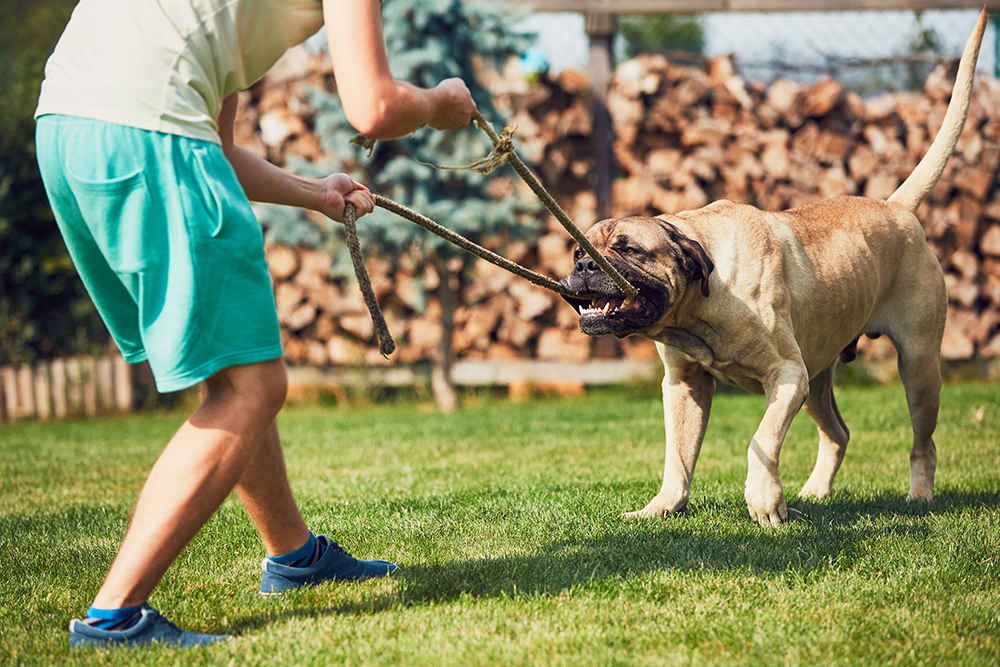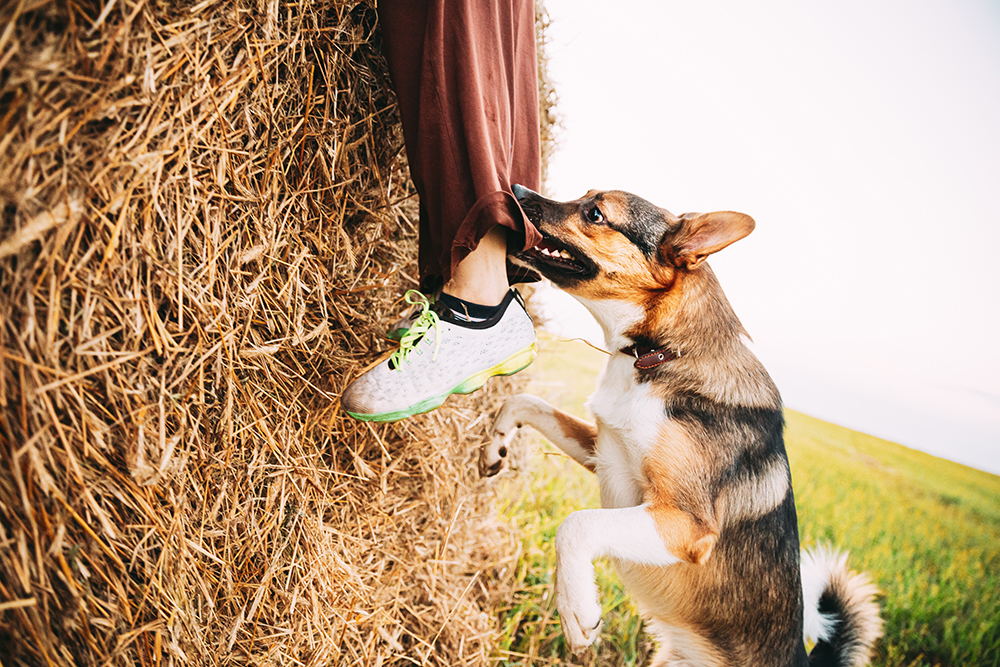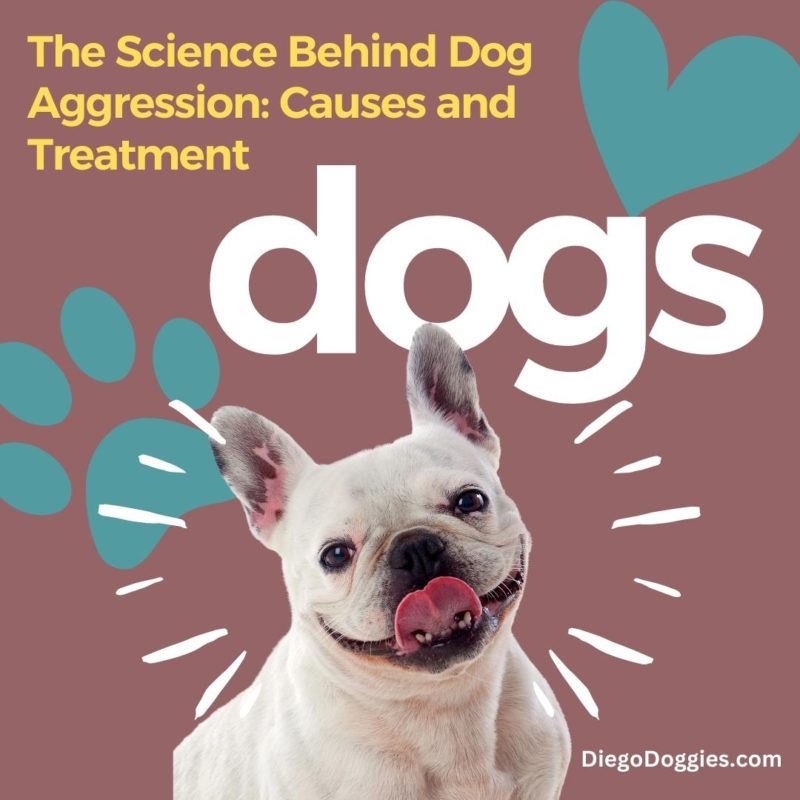Dog aggression can be a scary experience for dog owners, so understanding the science behind it is so important. Dog aggression can stem from various sources, including genetics, lack of socialization, fear or anxiety, pain or illness, resource guarding, and even learned behavior. Different forms of aggression should be identified correctly to provide the best possible treatment options–including breed-specific considerations.
Dog aggression also brings up legal and ethical implications for dog owners. Fortunately, these issues can often be avoided with careful training techniques focusing on early socialization and consistently reinforcing good behaviors. Dog aggression doesn’t have to be a danger; proper knowledge about its causes and treatments helps you keep your pup safe!
Definition of Dog Aggression
Dog aggression is a complex phenomenon associated with various behaviors and circumstances. Therefore, understanding causes of dog aggression is essential to diagnose and effectively treat this particular canine behavior. Dog aggression often stems from fear, territoriality, protective tendencies, or a combination of these factors.
Generally speaking, panic or stress can be triggered when a perceived threat – such as an unfamiliar person or pet – presents itself in real life. Additionally, suppose an animal feels threatened by an agreement breach, like not having its food bowl removed. In that case, it may become aggressive towards the perpetrator – even if it’s someone closer and known more intimately.
Fortunately, if treated appropriately, dog aggression does not have to be a permanent affliction for your pup. With patience and love, owners should look into positive reinforcement techniques that focus on rewarding desirable behaviour to replace unwanted ones.
Importance Of Understanding The Causes Of Dog Aggression
Dog aggression is a serious problem that can have severe consequences for both dogs and people. That’s why it’s so important to understand its causes. Knowing why your dog is acting out can help you target the underlying issues and develop a treatment plan tailored to your pet’s needs.
Aggressive behaviour may be caused by fear, illness, stress, or genetics, among other things. By looking for the root of the problem and getting professional advice as needed, you can address your canine companion’s aggression in a practical, gentle manner. In addition, understanding the causes of dog aggression will help reduce the risk of harm and lead to a healthier relationship between you and your beloved pooch.
Overview of The Topics Covered
This outline covers the topic of dog aggression and provides an overview of the causes, types, identifying signs, treatment, and prevention of aggressive behaviours in dogs. It discusses genetic factors, Lack of socialization, fear and anxiety, pain or illness, resource guarding, and learned behaviour as potential causes of dog aggression.
It also covers different types of charge, such as territorial aggression, fear aggression, and possessive aggression, as well as identifying physical, behavioural, and contextual signs of attack. Treatment options for aggressive dogs include positive reinforcement training, desensitization and counter-conditioning, medications, and environmental management.
The outline also addresses breed-specific aggression, legal and ethical considerations, and ways to prevent aggressive behaviors in dogs through early socialization, proper training techniques, and consistent reinforcement of positive behaviors.

Understanding the Causes of Dog Aggression
1. Genetic Factors
Dog aggression is a severe problem for pet owners, and understanding its causes is extremely important if humans want to reduce it. In recent years, research has been conducted to uncover the genetic factors contributing to dog aggression.
Studies have revealed that some breeds are especially prone to aggression due to their genotype, making it necessary for owners to be more alert when choosing a pup from such species. Recognizing the role of genetics in canine behavior can also help us identify dogs predisposed to aggression so we are better prepared when caring for these animals. Therefore, understanding the causes of dog aggression is critical since human intervention and supervision will be especially beneficial in such cases.
2. Lack of Socialization
Lack of socialization is one cause that people may not often recognize- by exposing our pets to different settings, environments, and other animals early, and we can help them adjust to different life scenarios.
Dog aggression due to Lack of socialization may manifest as fear or discomfort in new environments. Understanding how our pets learn to be comfortable in various situations is essential for owners who want to have well-socialized fur babies!
3. Fear and Anxiety
It is essential to understand that dog aggression is often rooted in fear or anxiety. If we can better understand the source of these emotions, we can take proactive steps to help address our furry friends’ behaviors. Dog owners should get familiar with the potential sources of aggression, fear and anxiety that might trigger their pet’s aggression, such as loud noises, confinement, or unfamiliar people or animals.
Recognizing signs of charge in your dog is vital to prevention, and a variety of resources are available to help provide strategies to reinforce good behavior properly and positively. Ultimately, by understanding the root causes of aggressive behavior in dogs, you can equip yourself with tools to help ensure your dog lives his happiest life.
4. Resource Guarding
Dog aggression can be a frightening experience for pet owners, especially regarding resource guarding. Understanding the causes of dog aggression is essential since most of these behaviors are preventable with early identification and training.
Unfortunately, an aggressive reaction is often due to a continued lack of education and understanding from the pet owner or family, leading to fear-based or dominant aggression. Therefore, a better experience of why your dog may act this way can help you identify the proper action for prevention and long-term remedial measures.
Understanding the basic theory behind resource guarding—the idea that a pet perceives something as valuable—is also essential for identifying signs and taking appropriate steps for de-escalation in such situations.
5. Pain or illness
One of the most common causes of dog aggression related to pain or illness is when a dog feels threatened by an external source and lashes out because it cannot defend itself in any other way. For example, suppose your dog has been experiencing chronic pain or illness due to a medical condition.
In that case, it could be more likely to become aggressive toward people or animals that try and interact with them. However, it’s also important to remember that all forms of aggression – even those triggered by pain or illness – can have lasting consequences. Therefore, understanding the underlying cause of your pup’s behavior early on is essential for keeping everyone safe.
6. Learned Behavior
Understanding what causes dog aggression is essential in helping protect dogs and those around them. Dog aggression often comes from learned behavior, such as being reactive to the sounds of loud noises or aggressive posturing when feeling threatened.
By better understanding common causes of canine aggression, we can take more steps towards recognizing signs early on and diffusing potentially dangerous situations. In addition, we all must work together to build relationships between dogs and people by finding ways to manage, prevent, and even reduce these instances of aggression.

Types of Dog Aggression
1. Territorial Aggression
Dog aggression is a natural behavior that various causes can trigger. Understanding the different reasons behind territorial aggression in dogs is essential to deal with it optimally. Territorial aggression occurs when a dog feels ownership or dominance over something, such as their yard or home.
This can cause them to become hostile toward humans and other animals that enter their “space.” The primary causes of territorial aggression include a lack of socialization, fear, anxiety, and health challenges such as pain or disorientation. Dog owners must invest the time and effort to identify the cause behind this aggression to create an environment where their pets and visitors feel safe. Taking steps to remedy the issue in advance could save your pet from future harm —and potentially legal troubles —down the line.
2. Fear Aggression
Dog aggression, especially fear aggression, is most commonly caused by underlying stresses or fears within the environment surrounding the dog. If you think your pup is suffering from this type of aggressive behavior, try to observe their daily activities and explore what possible external stimuli may have triggered it to manifest.
By recognizing the potential causes that could contribute to the dog’s aggression, you can better understand how best to alleviate their symptoms and help your four-legged companion. After all, dogs deserve love and understanding too!
3. Dominance Aggression
Dominance aggression is a common cause of dog aggression and stems from the dog’s perception that they need to exert dominance over other dogs and people. Awareness of this cause opens up new avenues for addressing and possibly correcting the problem before it becomes overwhelming or out of control.
Dog owners should understand the warning signs and triggers associated with dominance aggression to take pre-emptive steps in case an incident arises. Understanding the root cause behind dog aggression also gives owners faith in their pet’s potential and confidence in their ability to manage conflicting situations.
4. Possessive Aggression
Dog possessive aggression is a severe behavior issue with devastating consequences if not addressed adequately. Possessive aggression is particularly concerning due to its unpredictable nature and how difficult it can be to diagnose and treat. That is why it is essential to understand the underlying causes of dog aggression to address the issue quickly and effectively. Knowing things like extra sensitive territorial nature, fear of specific people or objects,
Lack of socialization training, frustration over confinement, past adversities and abuse, and improper breeding can help identify aggressive behaviors appropriately, recognize what triggers particular types of aggression in different situations and take appropriate action to protect both humans and other animals from harm.
5. Redirected Aggression
Dog aggression is critical to understand and manage, especially regarding Redirected aggression. This type of aggression occurs when a dog, provoked by a situation or other animal in the environment, turns their aggressive feelings towards another person or object nearby.
For example, suppose a pet parent wants to ensure their pet’s well-being and the safety of themselves and those around them. In that case, they must discover what causes their dog’s aggression and how to prevent it or redirect it away from themselves and others.
Through careful observation, consistent reinforcement techniques, and training directed towards specific needs, owners can better comprehend why their pup behaves aggressively and ultimately take steps to modify it before an incident arises. Utilizing these tactics in concert with one another will produce the best results for all affected by dog aggression.

Identifying Signs of Dog Aggression
1. Physical Signs
Dog owners must be able to identify warning signs of aggression to prevent any potentially dangerous situations. The physical symptoms of dog aggression include, but are not limited to, growling, snarling, showing teeth, sudden stiffening, accentuated postures, and lowered ears. By being aware of these physical signs and understanding a dog’s body language, pet owners can be proactive about their canine companion’s emotional needs and head off any behavior issues before they become destructive or dangerous.
It is essential for everyone who interacts with a dog regularly—owners, family members, and friends alike—to recognize physical signs of dog aggression to keep the canine safe and happy.
2. Behavioral Signs
Identifying the signs of Dog Aggression is incredibly important in understanding your pup’s behavior and ensuring you can adequately address any potential issues. Frequently, Dog Aggression isn’t as outwardly evident and recognizable as we would assume. As such, recognizing the more subtle behavioural signs that can accompany Dog Aggression is an integral part of being a responsible dog owner.
Watching for things like body language, excessive barking, hyperactivity, and possessiveness is critical for keeping our furry friends safe and happy. In addition, knowing when to intervene when dog aggression manifests is crucial for maintaining a positive relationship between you and your pup!
3. Contextual Signs
Pay attention to what are known as contextual signs of dog aggression – common behaviors in different situations that can help you anticipate and address emerging aggression before it escalates.
It’s not just about being alert for snarling or lunging, but understanding the context of how and when these behaviors show up – like if someone goes to pick up a bone the pup has already claimed – and making sure you never place your dog in situations where they could feel threatened or uncomfortable enough to become aggressive.
Identifying and understanding these contextual signs puts you closer to preventing or managing any unfortunate episodes involving your pup.
Treatment for Aggressive Dogs
1. Positive Reinforcement Training
When treating aggression in dogs, positive reinforcement training is critical. Dog aggression is a complex issue, often rooted in fear and discomfort, so reactive treatment methods are ineffective. With positive reinforcement, owners can reward good behavior with encouragement and treats instead of scolding or punishing aggressive behavior. This trains the dog that they can be rewarded for kind actions rather than impulsive ones.
Positive reinforcement doesn’t just improve behavior; it has also been shown to make dogs happier overall! So if your canine companion is exhibiting signs of aggression towards other animals or people, remember the power of positive reinforcement training as the best way to address these issues.
2. Desensitization and Counter-Conditioning
Dog aggression can be complex, and many factors can affect how it manifests itself. However, no matter the type, one of the most effective treatments for aggressive dogs is desensitization and counter-conditioning. These processes can help to teach the dog more appropriate behavior while also helping to decrease and manage their responses to specific triggers that may set off an aggressive response.
Desensitization focuses on gradually exposing the dog to the stimuli in a safe and controlled environment and helping them feel calmer when faced with them again outside of this environment. Conversely, counter-conditioning replaces negative associations with rewards, ensuring that positive feelings replace negative ones when faced with these triggers.
Working together, these two treatments have proven to be an effective way of managing aggression in dogs over time, making them an integral part of any treatment plan for dealing with this issue.
3. Medications
The good news is that treatment for aggressive dogs by medication is highly effective at reducing dog aggression while improving their quality of life. But, unfortunately, the remedy is often not enough; it should be administered alongside a comprehensive program that includes training and behavioral modification techniques.
If you are worried about your dog’s aggressive behavior, seeking professional help from an animal behaviorist is highly recommended to ensure the best possible outcome for you and your pet.
4. Environmental Management
Dog aggression is a serious issue that can lead to dangerous consequences. Treatment of aggressive dogs is essential to ensure the community’s safety, and environmental management is one effective way to do so. This type of treatment entails creating a calm and safe environment for the dog with well-defined boundaries, rewards for good behavior, and consistent verbal correction for aggressive behavior.
Environmental management also eliminates any triggers or stressors in the home environment that could be causing the dog’s aggressive displays. By making these changes in a pet’s life, we can help reduce their overall anxiety and decrease episodes of aggression when managed correctly.
Dog owners should never put off treatment for aggressive dogs because it could have life-threatening implications both for their pups and their loved ones.

Breed-Specific Aggression
1. Commonly Misidentified Breeds
While breeds like pit bulls and German shepherds are commonly misidentified as aggressive, dogs of any breed can show signs of aggression. Dog owners must know this and have the resources and knowledge to provide proper treatment.
As much as it can depend on individual dog behavior, there can also be breed-specific aggression tendencies that owners should be aware of when attempting to address a situation. It’s essential not only to understand the background of each breed and their typical behaviors but also to identify triggers for aggressive behavior for owners to adequately and quickly react safely for all involved, including the dog.
In addition, treatment plans should consider particular personality traits associated with the canine’s specific breed to create an effective action plan and support to manage aggressive tendencies.
2. History of Breed-Specific Legislation
Dog aggression often leads to breed-specific legislation discriminating against certain types of dogs. This poses enormous risks from both public safety and welfare perspectives. The good news is that dog aggression can be successfully treated with specialized training and targeted interventions.
Dogs are naturally social animals, and with expert help, even the most aggressive dogs can learn to trust people and develop healthy, safe behaviors around them. Dog owners should seek professional help whenever they notice signs of aggression or other behavioral problems in their pets.
Effective treatment is critical not only to ensure the well-being of our furry friends but also to thwart the potential damage caused by breed-specific legislation that unfairly targets dog breeds.
3. Role of Responsible Breeding Practices
Treating dog aggression requires professional help, but responsible breeding practices can also be essential in controlling this behavior. Breeding dogs with the right genetics, in combination with proper training and socialization, can minimize the occurrence of aggressive behavior in dogs by predisposing specific physiological changes related to puppy growth.
Dog breeders should also be aware of potential triggers, such as fear or anxiety-related behaviors that could increase the risk of aggression in their puppies. Responsible breeders are more likely to produce friendly dogs that are less likely to present aggressive tendencies throughout their lives, making proper breeding practices critical and necessary for animal welfare and safety.

Legal and Ethical Considerations of Dog Aggression
1. Liability for Dog Bites and Attacks
Dog owners should act appropriately to ensure their pets are effectively managed and trained so that any aggression won’t lead to an incident with severe injury or death. Dog owners should understand that having liability in the case of their pet causing damage or harm can save them thousands of dollars in legal lawsuits.
Furthermore, if a person injures another due to irresponsible dog ownership, the consequences are severe and should be taken seriously for both owner and pet alike.
The importance of liability for dog bites and attacks cannot be overstated—protecting people from dangerous situations is always paramount!
2. The Responsibility of Dog Owners to Manage their Pets
Many dog owners aren’t aware of the consequences of not treating aggressive behavior. Dog owners should exercise preventative care, such as enrolling dogs in classes that teach them proper behavior, avoiding reinforcing harmful activity, and keeping the environment calm and safe.
While some forms of dog aggression may be out of an owner’s control, handling it promptly and adequately can ensure everyone stays safe and make for a healthier, happier relationship with our furry pals.
Dog ownership isn’t just about providing food and shelter; it’s about awareness of the requirements for canine safety, health, and well-being. If we all remember that responsibility when caring for dogs, nobody has to worry about potential danger from these gentle creatures!
3. The Impact of Breed-Specific Legislation
Dog aggression is an issue that cannot be ignored. While it is essential to treat each dog aggression case individually, breed-specific legislation has become increasingly prevalent in helping to reduce the number of these instances. Breed-specific legislation refers to laws based on a dog’s breed to limit any potential issues from certain species involving aggressive incidents.
In addition, this type of legislation will function as a preventative measure against uncontrollable outbursts, giving people time and reason to create responsible ownership environments and practice better treatments of their dogs – each one tailored to the individual cases.
All in all, breed-specific legislation goes a long way in providing safety measures while creating positive dog ownership environments.
Preventing Aggressive Behaviors in Dogs
1. Early Socialization
Dog aggression is one of dog owners’ most challenging issues in caring for their pets. But it can be essential to remember that preventing aggressive behaviors in dogs is possible, and the key lies in early socialization. Exposure to various people and animals from an early age can help dogs to build positive associations with that outside of their typical environment and teach them good behaviors.
Dog owners who take the time to expose their puppies to new experiences are likelier to have well-behaved, balanced adult dogs than those who do not exert any effort for proper socialization. Dog owners should also ensure that their pup is always well-supervised and monitored when playing or interacting with others.
Even the sweetest puppy can inadvertently exhibit aggression if a situation becomes too overwhelming. Through consistent training, practice, and patience, dog owners may be able to prevent aggressive behaviors in their furry friends better!
2. Proper Training Techniques
Luckily, many training techniques can help reduce and prevent aggressive behaviors from occurring. Taking the time to train your dog correctly will benefit their behavior and your relationship with them. Rewards-based positive reinforcement is one of the most impactful methods for treating dog aggression, as it reinforces good behavior and helps create a stronger bond between pet and parent.
Taking the extra steps by enrolling in an obedience class or collaborating with a professional trainer are essential steps to take when looking to prevent and treat aggressive behaviors in dogs.
3. Consistent Reinforcement of Positive Behaviors
One of the most effective methods for treating dog aggression is consistent reinforcement of positive behaviors. Owners should take the time to reward their pets whenever they demonstrate appropriate behaviors to encourage those behaviors over more aggressive ones.
Dog owners should also be sure to give their pets adequate exercise, which will help release stress and reduce the likelihood of aggression. Lastly, owners should provide their canine companions with plenty of mental stimulation through positive training sessions and brain games. With the right approach, dog owners can successfully prevent aggressive behavior in their pets.
Frequently Asked Questions And Answers
Conclusion
In conclusion, understanding the science behind dog aggression is essential to prevent and managing aggressive behaviors in dogs. Causes of aggression, such as genetics, lack of socialization, and fear, must be identified early, and appropriate treatment options, including positive reinforcement training and medication, should be considered.
Identifying the types of aggression, signs, and responsible breeding practices and managing the environment can also help prevent aggression. Legal and ethical considerations should also be considered, with liability for dog bites and attacks, breed-specific legislation, and the responsibility of dog owners to manage their pets being essential factors.
Finally, providing early socialization, proper training techniques, and consistent reinforcement of positive behaviors can prevent dog aggression and create a safer environment for pets and people.
Related Content
- 11 Important Tips To Help Your Dog Lose Weight and Become Healthier
- 11 Types of Dog Tails and What They Mean
- 12 Swimming Safety Tips for Your Dog
- 14 Ways to Help Keep Your Dog Happy and Healthy
- 15 Tips to Keep Your Senior Dog Healthy As They Age
- 5 Reasons Why Your Dog Needs a Dog Life Jacket
- A Step-By-Step Guide To Removing A Tick From Your Dog
- Can A Dog Sleep In A Soft Crate
- Collars Versus Harnesses for French Bulldogs
- Cutting a Dog’s Nails: How to Prevent Bleeding
- Dachshund Health Problems and How to Prevent Them
- Demand Barking- 10 Steps to Stop it
- Dog Itchy Skin Home Remedies
- Dog Obesity: How to Help Your Dog Lose Weight and Stay Healthy
- Dog Pregnancy Guide: Signs, Care And Preparation


